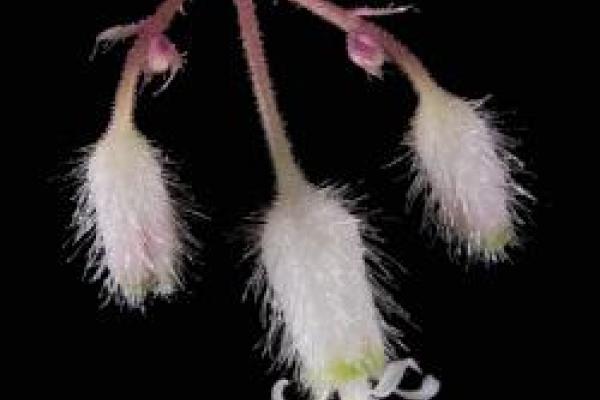Publications by EEOB faculty in 28 June - 7 July 2014

On left: focus-stacked image of Heuchera longipetala, by John Freudenstein.
Revision of Heuchera Section Rhodoheuchera Subsections Hemsleyanae and Rosendahliae Subsectio Nova (Saxifragaceae)
Ryan A. Folk and John V. Freudenstein. Systematic Botany 39(3):850-874. 2014. doi: 10.1600/036364414X682300
Abstract
A revision of a closely allied and poorly studied group of Mexican Heuchera species is presented. This work has necessitated several taxonomic and nomenclatural actions, namely: the recognition of the name H. longipetala as referring to the Mexican plant usually known as H. hemsleyana; the reduction of the latter to synonymy; the description of two new species, H. rosendahlii and H. wellsiae, having such divergent morphology as to warrant a new subsection, subsection Rosendahliae; the transfer of H. mexicana to subsect. Hemsleyanae; the description of a new variety for H. mexicana (H. mexicana var. potosiensis) and for H. longipetala (H. longipetala var. nudicaulis); the reduction of H. orizabensis to a variety of H. longipetala (H. longipetala var. orizabensis) and of H. amoena to a synonym of H. mexicana; and the lectotypification of the names H. orizabensis and H. hemsleyana. Provided are descriptions, notes on habitat and phenology, range maps, line drawings, and full specimen citations for all taxa treated, as well as a taxonomic key for all known species of Heuchera in Mexico, new chromosome counts for two taxa, and a morphological cladistic analysis of section Rhodoheuchera.
Ideal Free Distributions of Mobile Pastoralists in Multiple Seasonal Grazing Areas
Mark Moritz, Ian M. Hamilton, Paul Scholte, and Yu-Jen Chen. Rangeland Ecology & Management. In-Press. 2014. doi: 10.2111/REM-D-14-00051.1
Abstract
The pastoral system in the Far North Region of Cameroon is best described as an open system in which mobile pastoralists have open access to common-pool grazing resources. We hypothesized that there is a self-organizing management system of open access to common-pool grazing resources and predicted that we would find an Ideal Free Distribution (IFD) of mobile pastoralists within seasonal grazing areas. In this paper we used mobility data and remote sensing data from two seasonal grazing areas at the end of the dry season in three consecutive years to evaluate that hypothesis. We found evidence of an IFD in the two seasonal grazing areas of the Logone Floodplain and the Lake Maga area. These findings offer further support for our hypothesis that there is a complex adaptive system in which pastoralists distribute themselves effectively over available grazing resources.
Context-specific enhanced invasiveness of Raphanus crop-wild hybrids: a test for associations between greater fecundity and population growth
Lesley Geills Campbell, Zachary Teitel, Maria N Miriti, Allison A Snow. Canadian Journal of Plant Science. 2014. 10.4141/CJPS-2014-070
Abstract
Evolution by crop-wild hybridization may create plant lineages with greater population growth rates, dispersal, and persistence than weedy progenitors, depending upon plant density. We asked: (1) how does hybridization affect demography and population growth rate (lambda, λ)? and (2) how does density affect demography and λ? Over one year, we followed wild radish, Raphanus raphanistrum and crop-wild hybrid, Raphanus sativus x R. raphanistrum, plants grown in 18 experimental sub-populations (originally derived from three wild and three hybrid populations) to assess contributions of germination, survival, and seed production to λ. We explored genotypic differences in demographic characteristics of low- and high-density populations (from populations grown at unmanipulated densities for three generations), using a LTRE. Hybrid populations had greater λs than weedy progenitors when grown in low (but not high) densities. Seed production was more influential on λ than germination or survival, and seed mortality was least influential. Our results indicate weedy Raphanus populations may be best controlled by limiting seed production, rather than killing plants outright or preventing seeds from germinating. Furthermore, relative invasiveness of genotypes is density-dependent, low-density conditions improving potential invasiveness of hybrid populations. We emphasize that assessing invasive potential of a plant will be more successful if one uses a comprehensive demographic approach accounting for a weed’s entire life history.
Are antimicrobial defences in bird eggs related to climatic conditions associated with risk of trans-shell microbial infection?
Nicholas PC Horrocks, Kathryn Hine, Arne Hegemann, Henry K Ndithia, Mohammed Shobrak, Stéphane Ostrowski, Joseph B Williams, Kevin D Matson, B Irene Tieleman. Frontiers in Zoology. 2014. 11:49. doi:10.1186/1742-9994-11-49
Abstract
All bird eggs are exposed to microbes in the environment, which if transmitted to the developing embryo, could cause hatching failure. However, the risk of trans-shell infection varies with environmental conditions and is higher for eggs laid in wetter environments. This might relate to generally higher microbial abundances and diversity in more humid environments, including on the surface of eggshells, as well as the need for moisture to facilitate microbial penetration of the eggshell. To protect against microbial infection, the albumen of avian eggs contains antimicrobial proteins, including lysozyme and ovotransferrin. We tested whether lysozyme and ovotransferrin activities varied in eggs of larks (Alaudidae) living along an arid-mesic gradient of environmental aridity, which we used as a proxy for risk of trans-shell infection.
